To what extend have Justine Kurland and Jeff Wall explored narrative in their work?
Introduction:
‘If you wanted a place in the narrative, you had to imagine yourself inside of it.’ -Justine Kurland, ‘Girl Pictures.’ 1
My intention for this study is to explore the themes of youth and identity by creating narratives personal to my own youth and identity. Specifically, I am going to focus on female identity and female stereotypes, and how they can be combatted against, as this is personal to me as a women. This subject is also extremely important for other women and young girls to demonstrate that your identity can be whatever you desire and that you do not have to comply with social norms, or expectations. I have also explored this in depth in my previous topics and was able to create visually pleasing images with powerful narratives. I would also like to present my female subjects ‘trying on a version of themselves that the world has thus far shown them was boy,’ 2so that I can present more masculine stereotypes and really exaggerate this point of opposing social ‘norms’. This topic of youth and identity interests me, because I think it would be interesting to see how my identity has changed from when I was younger, to now when I’m slightly older. I would also like to look back onto my youth, so that I can see what societal norms I followed and didn’t. I also would like to experiment with different compositional elements, such as the rule of thirds, so that I can improve the presentation of my narratives.
I am analysing Justine Kurland’s work, especially Girl Pictures, because the topic of youth and identity really interests me, because I am still exploring my own identity as I am growing, so this topic is also personal to me, especially because I am a female growing up in this society, who is held to certain expectations. This makes it important for me to combat stereotypical norms, so that I can be myself and help other women do the same thing and express their true identity through the narratives I am presenting. I also feel like because this topic is so personal to me it will allow me to create good photographs to display my feelings and opinions.
I am also analysing Jeff Wall’s images and how he creates his narratives and uses different compositional elements. Jeff Wall takes inspiration from historical paintings, similarly to Justine Kurland. I am also going to be pulling ideas, concepts and compositions from not only his work, but historical paintings as well, especially Le Déjeuner sur l’herbe painted by Édouard Manet in 1863.
So far in this study I have started recreating activities I used to do in my youth, so that I can present my identity and youth through the narratives of my images. I have created tableaux images, where I have positioned and manipulated my subjects. I have also experimented with compositional elements a little bit, by experimenting with the foreground, middle ground and background. To further develop my work, I would like to improve my compositional elements more, by experimenting with the rule of thirds for example and I would like to take inspiration from historical paintings, similarly to Justine Kurland and Jeff Wall. I would also like to focus on trying to create a different range of activities ranging from more feminine to more masculine elements.
Historical context
Tableaux photography is a staged photograph in which characters are arranged for picturesque or dramatic effect in a constructed environment, but the photographs appear to be candid photographs, as the characters appear absorbed and completely unaware of the viewer. This conveys a pictorial narrative through a single image and ‘narrative is crucial to photography,’ 3especially in tableaux photography, as it ‘relies on a narrative for it’s readings.’ 4Tableaux photography originated from Pictorialism, which was a union of photographers that fought to separate photography as an art form from photography used towards various scientific and documentary purposes, as they focused on the beauty of subject matter and the perfection of composition rather than the documentation of the world as it is. Photography was viewed as a scientific experiment by many, because photography originated from scientists, such as Louis Daguerre and Nicéphore Niépce. The Daguerreotype was created in 1839 from many scientific experiments made from these two scientists and it created photographs on silver-plated copper sheets using light and chemicals, such as mercury vapour to create these photographs. From the 1800’s and onwards photographers strived for photography to be art by trying to make images that resembled paintings, especially Allegorical paintings. Allegorical paintings communicate deeper moral, social, religious, political or spiritual meanings, such as life, death, love, virtue, justice, charity, greed, envy and more. Allegorical paintings tend to communicate these messages by using symbolic figures, actions or symbolic representation, such as angels, or wings. In order to create images that resembled paintings they had to manipulate images in the darkroom, scratching and marking their prints to imitate the texture of a canvas, using soft focus, blurred and fuzzy imagery based on allegorical and spiritual subject matter, including religious scenes.
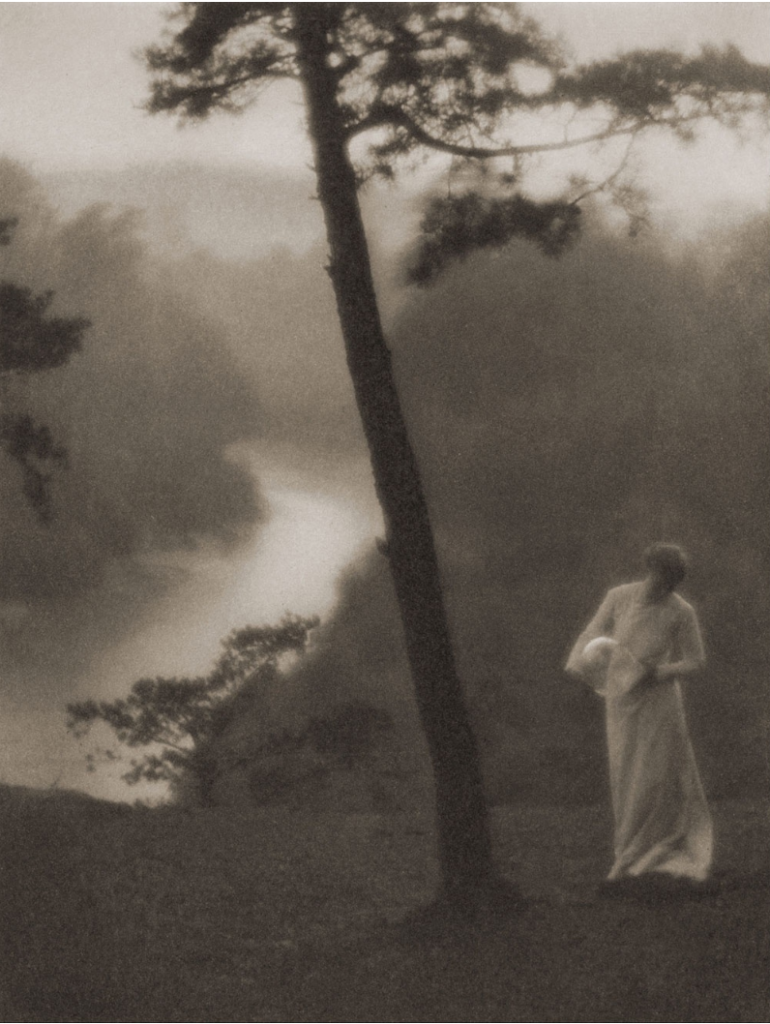
Julia Margaret Cameron was a photographer in the Victorian era, who supported the Pictorialism movement and was considered one of the most important portraitists of the 19th century. She was born on 11th June 1815 and died on 26th January 1879. She is known for her soft-focus close-ups of famous Victorians and for illustrative images depicting characters from mythology, Christianity and literature. She mainly used siblings as her models, including her own sisters, and her daughters, so that they would all look very similar in her photographs. She created allegorical images inspired by tableaux vivants, theatre, 15th-century Italian painters and contemporary artists. In the allegorical works in particular, her artistic influence was clearly Pre-Raphaelite, with far-away looks and limp poses and soft lighting. Pre-Raphaelite would urge artists to ‘go to nature,’ (Wikipedia) as they believed in an art of serious subjects treated with maximum realism. Their principal themes were initially religious, but they also used subjects from literature and poetry, particularly those dealing with love and death, very similarly to Cameron’s work. Cameron was contentious in her own time and her photographs were unconventional in their intimacy and their particular visual habit of created blur through both long exposures, where the subject moved and by leaving the lens intentionally out of focus.



Justine Kurland
A notable influence within tableaux photography is Justine Kurland, who utilizes a narrative of young runaway girls in a staged environment, where she manipulates the positions/ layout of her subjects to create aesthetic compositions in all her photographs. She carefully composes all her tableaux images, as she manipulates the narrative to be whatever she desires. Justine Kurland borrowed ideas, concepts and compositions from old historical paintings (masters). An examples of her borrowing from a master is ‘Le Dejeuner sur L’Herbe’ by Edouard Manet, which was created in 1862-63.
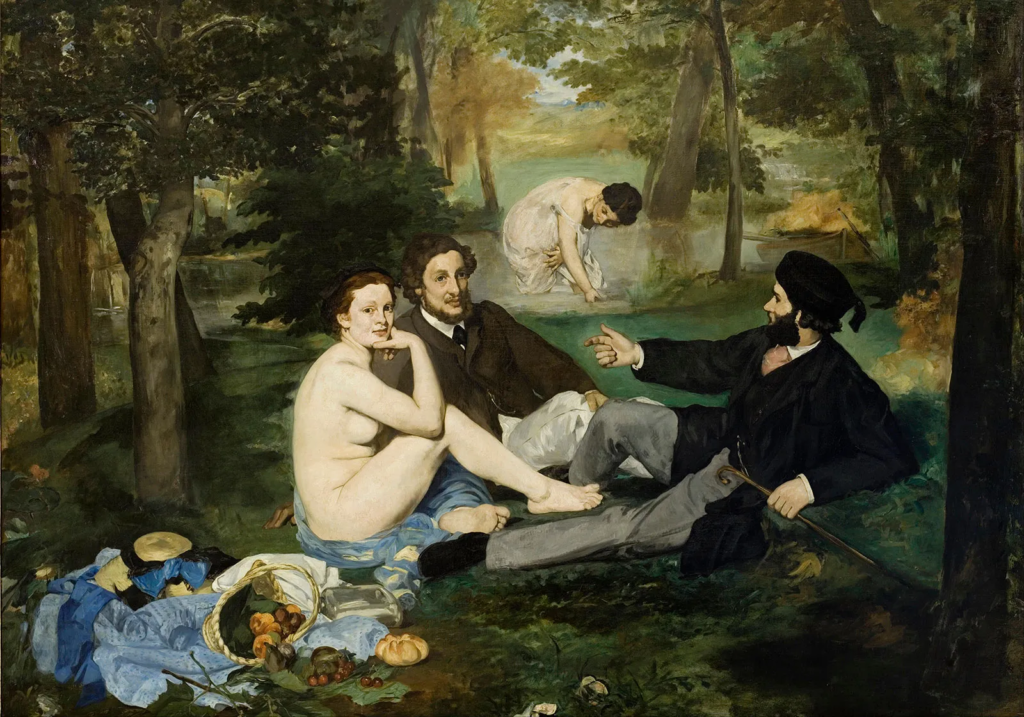
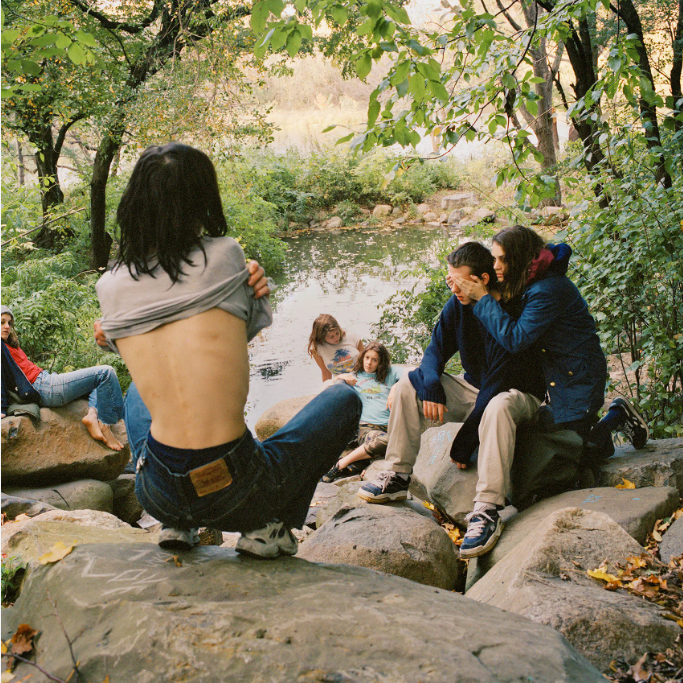
This painting includes a nude women in the foreground of the painting, who is lunching with two fully dressed men, who are in the middle ground of the painting. They also seem to be having a picnic in a woods, which is presented by the setting of the painting and the picnic basket containing fruit. This suggests they are lunching, as the title of the painting states. ‘Le Dejeuner sur l’herbe’ is French and states ‘Lunch on the grass.’ There is also a half dressed women in the background of this painting, who is washing herself/ swimming in the lake. This painting was very scandalous back in the 1800s, as public nudity was seen as vulgar and frowned upon by society. This was because nudity was a very private concept back in that time, so the models for this painting would have most likely been prostitutes, as a respectable women would not have done this, or been allowed to in this time period.
Justine Kurland borrowed the concept and the composition from this famous painting. As seen in the painting and the photograph, the settings are quite similar, as they are both scenic landscapes, which are wooded, with trees in the distance, as well as the lake in the background. She has also borrowed the nudity concept from the painting, as she has a young girl lifting her top in the photograph, as if she is undressing to get in the lake. She has also borrowed the composition from the painting, as well as other visual elements, such as the colour and texture seen in both the painting and the photograph. Justine Kurland has used the same layout of having the ‘nude’ girl in the foreground, with people in the middle ground, as well as more people in the background down near the lake.
Justine Kurland explores the theme of identity throughout her work, through narratives. The narrative of her work in Girl Pictures is that ‘the girls were rebelling. The girls were acting out. The girls had run away from home… Cowboys, sailors, pirates, hitchhikers, hobos, train hoppers, explorers, catchers in the rye, lords of the flies- you name it.’5 In Girl Pictures the girls weren’t just girls they were whoever they wished to be, as they are finding their true identity during their youth. She also states that they are in ‘the dominion of boys,’6 because in societal standards it is more socially acceptable for boys to act in this rambunctious manor, rather than girls. This is due to gender stereotypes, which have been seen through many centuries. Justine Kurland is trying to fight against these stereotypes of young girls, in her work, because this is an important matter to her and all other girls, because they have grown up being told what they should be or how they should behave a certain way due to their gender. She is fighting against these stereotypes, by having these young girls act in a way that is seen as more masculine and not socially acceptable for these girls. Youth is also an important theme throughout her work, as she presents these girls exploring their identity in their youth, which is extremely important, because during youth you do not know who you fully are yet and being able to explore every aspect of your youth and identity, even if it does not comply with social ‘norms’ allows you get the truest sense of your identity possible. Her message that she is presenting to the viewers through this work is that they can be anything they image, even if it is still in the ‘dominion of boy.’7
Jeff Wall
Another notable influence within tableaux photography is Jeff Wall. Jeff Wall creates tableaux photographs, by manipulating his subjects and he also borrows ideas, concepts and compositions from 1900th century classical paintings from the Baroque period, including ‘Le Dejeuner sur L’herbe’ by Edouard Manet. However, he alters the narratives of his photographs to present a more modern day version of the paintings, while still keeping the same compositional elements and concepts. On the influence of Baroque painting in Wall’s images he has said, ‘my work is based on the representation of the body. In the medium of photography, this representation depends upon the construction of expressive gestures which can function as emblems.’ (Wall 1984). In his body work he often captures a snapshot of ordinary street scenes and social encounters in everyday life that may as well have gone unacknowledged, as well as also exploring a range of social and political themes through his work. He also digitally manipulates his work at times, to confuse the viewer even more, so that they have to look harder at his work and think more deeply about the narrative and the role of the photograph itself.
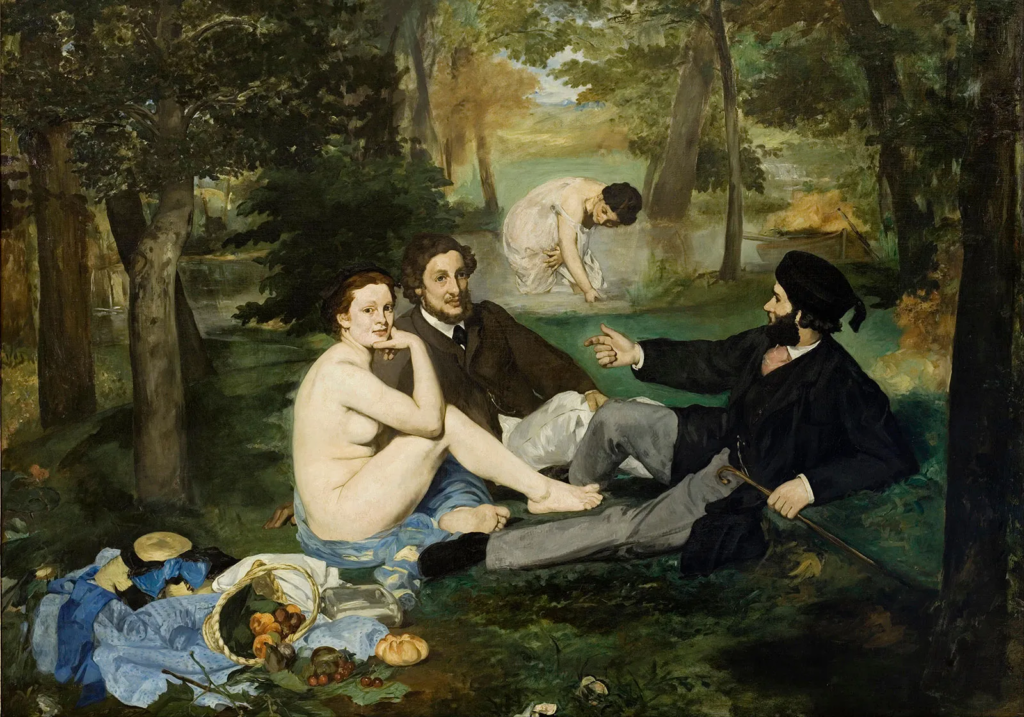
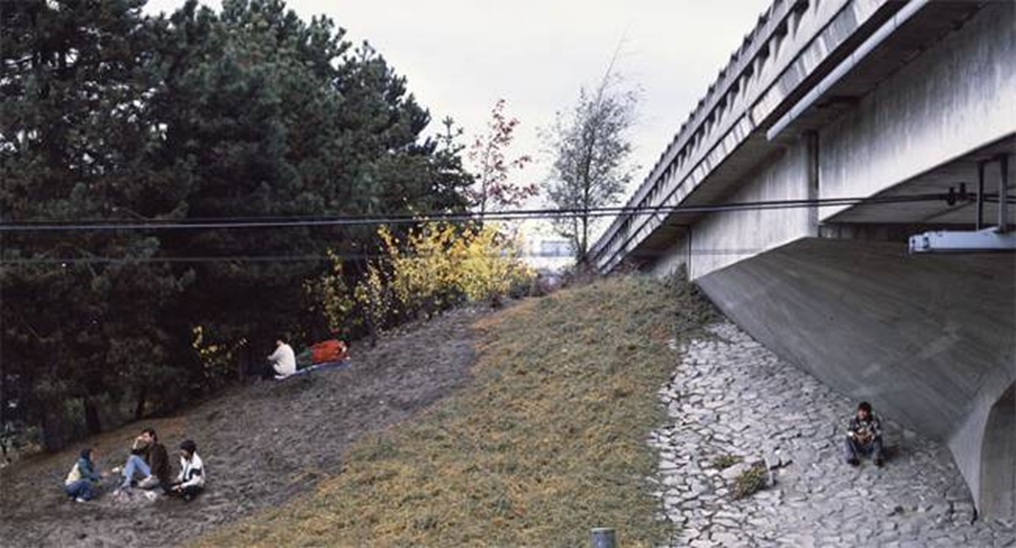
Jeff Wall has created a tableaux image, where he has manipulated the positioning and location of his subjects and himself. He has also borrowed the composition that was used in Manet’s painting for his photograph, by having the three people in the foreground on the left, the person on the right in the middle ground and the far people in the background. He has also pulled from the setting a little bit, as the setting is in field like area with trees on the left. However, he has made a more modern day version of this painting by including the bridge, which is a modern day structure in his photograph.
Conclusion:
Overall, both Justine Kurland and Jeff Wall share similar inspirations, as they both pull ideas, concepts and compositions from old historical paintings and create unique more modern narratives in doing so. They also use similar paintings for their inspiration, which can be seen as they have both used Manet’s painting- ‘Le Dejeuner sur L’Herbe.’ However, they create and explore different narratives in their work, even when using similar inspirations. Justine Kurland explores the themes of youth and identity throughout her work, specifically in Girl Pictures. In order to explore these themes in her work, she presents a range of different narratives of young girls doing a range of different activities, such as swimming in lakes, playing at a park, laying on the beach etc. While she is presenting what is seen as simple narratives, they actually all have a deeper meaning behind them, as she is presenting to the viewer that these girls are doing all these things, because they can be whoever they desire to be and their identity can be whatever they decide to make it. She also presents the young girls doing more stereotyped boy-like activities, such as playing in the woods and wrestling etc, so that she can present to the viewer that they don’t need to follow societal ‘norms’ and they can be anything they imagine.
Whereas, Jeff Wall creates more simplistic narratives, such as sitting in the park, or lying on the grass etc. He says, he is ‘not interested in narrative,’ (Wall 1984) because he focuses more on the compositional and visual elements in his work. This makes his work more technically complex.
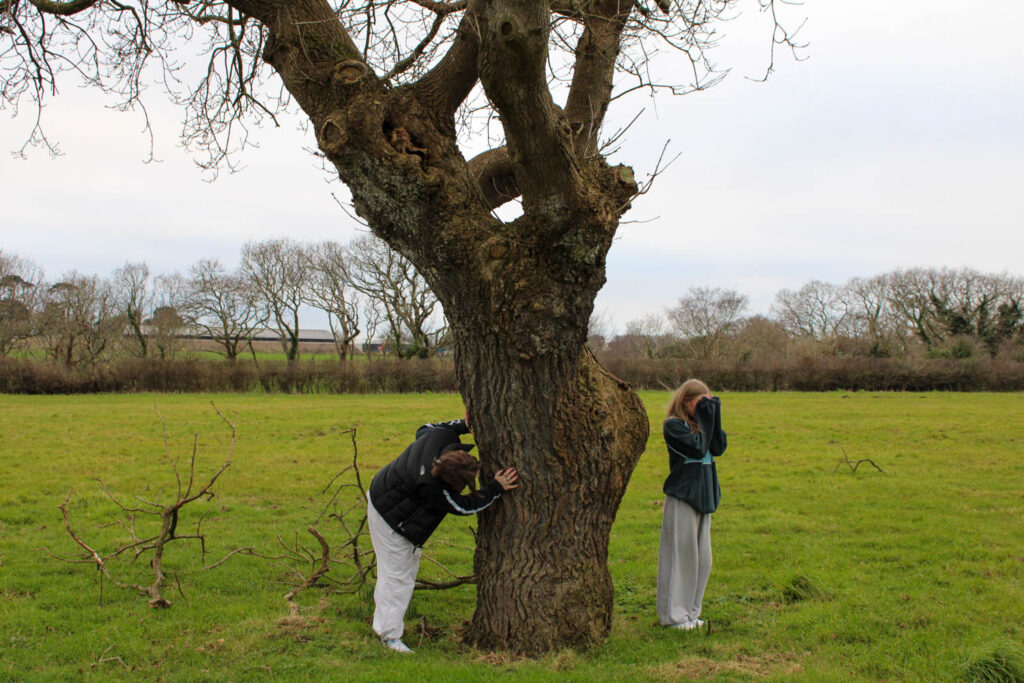
In this image, I focused on my composition, similarly to Jeff Wall. I experimented with the rule of thirds, by having my subject on the left in the left hand third, the tree in the centre third and my subject on the right in the right hand third. I focussed on my composition in this image, so that I could produce an aesthetically pleasing image. The narrative of this image is that the subjects are playing hide and seek with the subject on the right counting and the subject on the left hiding. This relates to Justine Kurland’s work, as I have presented young girls acting out a narrative, by having them do a fun activity, which in this case is playing hide and seek, which presents their youth and identity. This image also specifically reflects my youth, because when I was younger I used to play hide and seek all the time with my friends. This in turn then looks at my identity, because it looked at who I used to be and who I am now and how my identity has changed from during my youth to now.
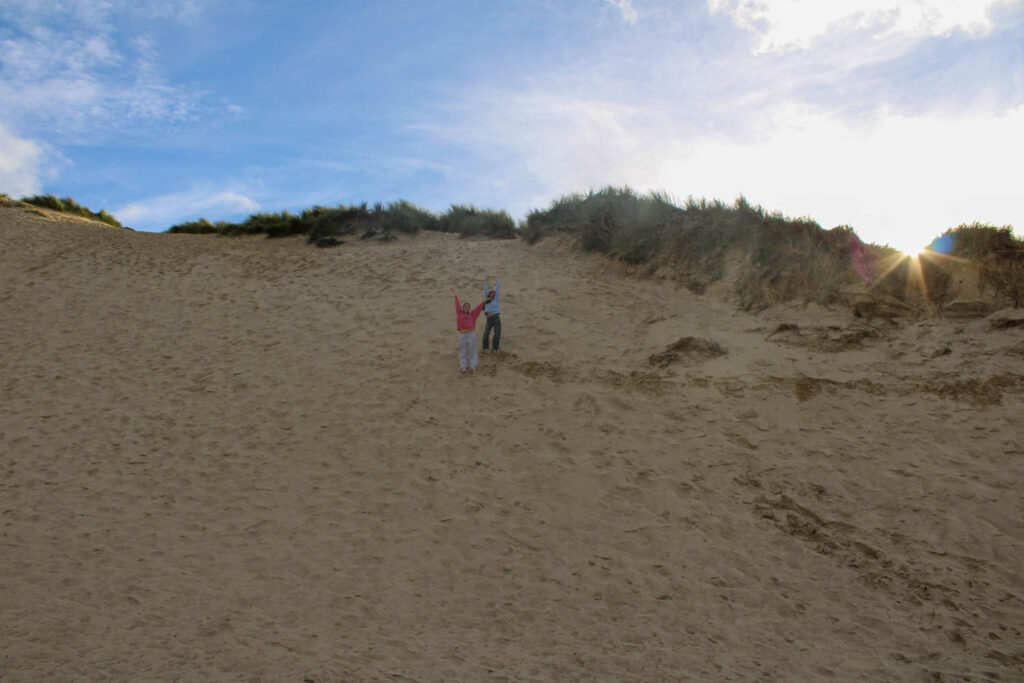
This image also relates specifically to my youth and identity, because the setting of this image is the sand dunes, and both subjects have climbed up the 100 foot hill, which is what I used to do in my youth every Summer. This relates to the theme of identity, because this image relates to who I was in my youth, as it displays an activity I enjoyed doing. This image also relates to Justine Kurland, as I have presented a narrative of a specific activity, which was done by my two subjects. This image also relates to Jeff Wall, as I have positioned my subjects in the centre of the frame, so that they are the main viewpoint.
References:
- Justine Kurland, ‘Girl Pictures’ (2020) ↩︎
- Justine Kurland, ‘Girl Pictures’ (2020) ↩︎
- Bright, S. (2005). ‘Narrative’ in Art Photography Now. New York: Aperture. ↩︎
- Bright, S. (2005). ‘Narrative’ in Art Photography Now. New York: Aperture. ↩︎
- Justine Kurland, ‘Girl Pictures’ (2020) ↩︎
- Justine Kurland, ‘Girl Pictures’ (2020) ↩︎
- Justine Kurland, ‘Girl Pictures’ (2020) ↩︎

Jessica, see my comments in ( ) directly in your blog post.
Jessica, I’ve done a second reading and made some minor changes directly in the essay. I’ve left a few strikethrough sentences for you to delete.
Apart from that just find one more illustration representing Pictorialism and also add image captions to illustration by Julia Margaret Cameron – see my comments in ( ).